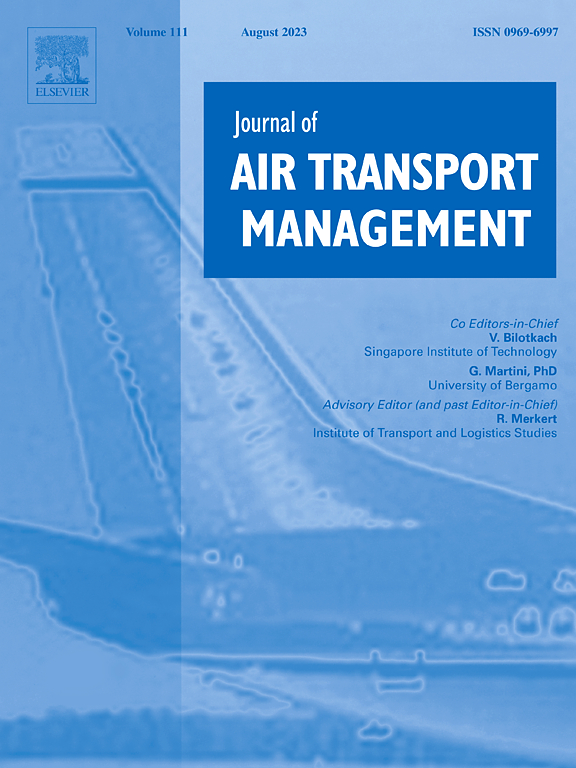Curved flight procedure construction with site-specific statistical meteorological data: A Swedish example
IF 3.9
2区 工程技术
Q2 TRANSPORTATION
引用次数: 0
Abstract
This paper presents a study of using site-specific statistical meteorological data in the construction of curved flight procedures to explore its potential in reducing the environmental impact of air traffic near the airports. In the study, the statistical meteorological data which covers a 10-year period of time, from 2009 to 2018, have been collected for the air space centred two major Swedish airports, Arlanda at Stockholm (ESSA) and Landvetter at Göteborg (ESGG). Two procedure design practices, one is an area navigation (RNAV) standard instrument departure (SID) procedure from runway 08 of Arlanda airport and another is a required navigation performance authorization required (RNP AR) approach procedure heading to the runway 03 at Landvetter airport, have been performed and analyzed. Applying the 95th percentile wind speed from statistical meteorological data, instead of the ICAO standardized tailwind component (TWC), offers varying benefits depending on the specific case. For the RNAV SID procedure from ESSA, the part of the designed departure path which is outside of the regulated noise dispersion area is significantly reduced. Whilst for the RNP AR approach procedure to ESGG, the smaller turning radius resulted from the lower TWC which is calculated from the local meteorological data makes it possible to avoid flying over an inhabited area. Besides the notable potential of noise impact reduction, flight distance shortening of 3.7 NM (RNAV SID ESSA case) and 1 NM (RNP AR ESGG case) compared to the same procedures designed on ICAO standard TWC have been observed. In general, the presented results are positive in supporting the use of local meteorological data in planning curved flight procedures during departures and approaches. A validation performed using an A320 full flight simulator has confirmed the operability of the ESGG RNP AR procedure from the design practice. In the full flight simulator, even with the 100th percentile wind condition from the collected statistical meteorological data, the designed RNP AR approach procedure can be operable considering RNP 0.3 corridor while a 30° bank angle is required for approximately 20 s during the turn.
利用特定地点的统计气象数据构建曲线飞行程序:瑞典范例
本文介绍了一项关于在构建曲线飞行程序时使用特定地点统计气象数据的研究,以探索其在减少机场附近空中交通对环境影响方面的潜力。在这项研究中,收集了以瑞典两大机场(斯德哥尔摩的阿兰达机场(ESSA)和哥德堡的兰德维特机场(ESGG))为中心的空域的气象统计数据,时间跨度为 10 年(2009 年至 2018 年)。对两种程序设计实践进行了分析,一种是从阿兰达机场08号跑道出发的区域导航(RNAV)标准仪表起飞(SID)程序,另一种是前往兰德维特机场03号跑道的必要导航性能授权(RNP AR)进近程序。根据具体情况,采用统计气象数据中的第 95 百分位数风速而非国际民航组织标准化尾风分量(TWC)可带来不同的益处。就 ESSA 的 RNAV SID 程序而言,设计的离港路径中位于受管制的噪声扩散区域之外的部分明显减少。而对于飞往 ESGG 的 RNP AR 进近程序,由于根据当地气象数据计算的 TWC 较低,因此转弯半径较小,可以避免飞越居民区。与根据国际民航组织标准 TWC 设计的相同程序相比,除了显著降低噪声影响的潜力外,还观察到飞行距离缩短了 3.7 NM(RNAV SID ESSA 案例)和 1 NM(RNP AR ESGG 案例)。总体而言,所提供的结果对在离港和进港过程中使用当地气象数据规划曲线飞行程序具有积极意义。使用 A320 全飞行模拟器进行的验证证实了 ESGG RNP AR 程序在设计实践中的可操作性。在全飞行模拟器中,即使在收集到的统计气象数据的第100百分位风况下,所设计的RNP AR进近程序在考虑到RNP 0.3走廊的情况下也是可操作的,而在转弯过程中需要约20秒的30°倾角。
本文章由计算机程序翻译,如有差异,请以英文原文为准。
求助全文
约1分钟内获得全文
求助全文
来源期刊

Journal of Air Transport Management
TRANSPORTATION-
CiteScore
12.40
自引率
11.70%
发文量
97
期刊介绍:
The Journal of Air Transport Management (JATM) sets out to address, through high quality research articles and authoritative commentary, the major economic, management and policy issues facing the air transport industry today. It offers practitioners and academics an international and dynamic forum for analysis and discussion of these issues, linking research and practice and stimulating interaction between the two. The refereed papers in the journal cover all the major sectors of the industry (airlines, airports, air traffic management) as well as related areas such as tourism management and logistics. Papers are blind reviewed, normally by two referees, chosen for their specialist knowledge. The journal provides independent, original and rigorous analysis in the areas of: • Policy, regulation and law • Strategy • Operations • Marketing • Economics and finance • Sustainability
 求助内容:
求助内容: 应助结果提醒方式:
应助结果提醒方式:


